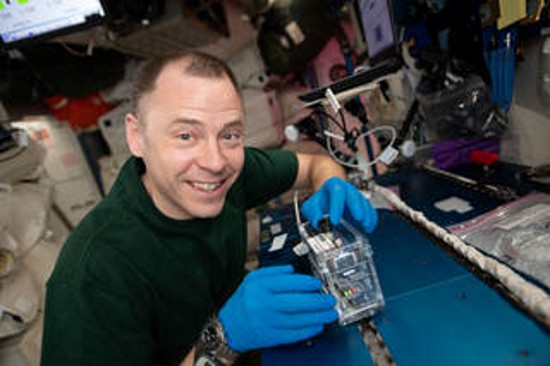Cosmic rays and solar radiation represent a significant threat to the health of humans or any other species of animal or plant venturing into outer space beyond the protection of Earth’s magnetic field and atmosphere. That’s why in response to a 2018 NASA Genes in Space contest related to long-duration space flight, a team of four young high school students devised a yeast DNA experiment that moved from their science lab to the one onboard the International Space Station (ISS). The experiment created breaks in the yeast DNA which were then repaired using CRISPR/Cas9 technology. The DNA was then examined for potential mutations. The experiment, conducted in 2019, eventually led to a paper submitted for publication.
If you are not familiar with CRISPR/Cas9, a quick search on this blog site using the term “CRISPR” will yield a number of pertinent articles. I have chosen one to highlight here to get you started. For those who worry that CRISPR/Cas9 is something alien to our DNA, it is not. The acronym stands for Clusters of Regularly Interspaced Short Palindromic Repeats and is embedded in DNA. CRISPR is the area of DNA that stores information when the genome is fractured by something invasive like a virus or an environmental insult (radiation). It becomes a reference library of things that negatively impact the genome.
Cas9 is a protein that specifically works with RNA to recognize DNA sequences. The protein can be used like scissors to cut out a DNA sequence that it recognizes as abnormal. When this happens naturally, DNA attempts a repair but often can make mistakes that leave imperfect strands which then become inactive. But scientists have turned CRISPR/Cas9 into a repair tool to assist DNA in editing out unhealthy strands of our genetic code and inserting healthy replacements to precise locations rather than allowing the natural attempt at repair to proceed.
Why add a CRISPR/Cas9 tool to health kits carried by future space travellers? Because galactic cosmic rays and solar radiation are part of the space environment passing through any human or other life exposed to space. These forms of radiation can have an acute effect on living things just like exposure to nuclear radiation causes changes here on Earth. Current astronauts visiting the ISS are monitored daily by NASA’s Space Radiation Analysis Group. Exposure is measured in different units. One of these is Sieverts (Sv), a measure of the health effect of low levels of ionizing radiation. Guidelines for specific organ exposures have been created as follows:
| Exposure Interval | Blood forming organs | Eyes | Skin |
| 30 Days | 0.25 Sv | 1.00 Sv | 1.50 Sv |
| Annual | 0.50 Sv | 2.00 Sv | 3.00 Sv |
| Career | 1.00 to 4.00 Sv | 4.00 Sv | 6.00 Sv |
A lethal dose of radiation as defined by the U.S. Nuclear Regulatory Commission is 4 to 5 Sieverts over a 30-day period that can lead to death in up to 50% of the exposed population within 30 days.
When the atomic bomb was dropped on Hiroshima, anyone directly below the air-detonated weapon was exposed to 155 Sv of radiation. Anyone within 500 metres of the bomb’s epicentre received 42 Sv of radiation. For the former, that’s equivalent to 1.55 million chest X-rays done simultaneously, and for the latter, 420,000.
Although space forms of radiation are less catastrophic than a nuclear weapon, they can be more insidious. That’s why the National Oceanic and Atmospheric Administration (NOAA) of the United States produces space radiation weather forecasts that monitor the Sun’s activity and cosmic radiation coming from outside the Solar System. Astronauts on the ISS plan extravehicular activities outside the station’s minimally protective walls based on these NOAA forecasts.
It should also be noted that the ISS is not in Deep Space. It is in low-Earth orbit and largely protected from space radiation sources because of the Van Allen Radiation Belt, a magnetic shield that extends well beyond the Earth’s atmosphere into near-Earth space. Astronauts that go to the Moon are not protected by the Van Allen Belt. That’s true of astronauts going to Mars as well.
With current state-of-the-art chemical rocket propulsion systems, going to Mars will be an epic voyage, each way taking six months. And the stay on Mars will be for18 months to allow for a favourable realignment to make the return trip as short as possible, another six months. The 30 months in total means an astronaut will be exposed to an estimated 1.2 Sv of radiation which exceeds the lower safety limit for blood-forming organs in our bodies. And that’s without taking into consideration solar flares and geomagnetic storms which potentially could increase radiation exposure.
So that’s why a molecular laboratory onboard Deep Space missions in the future may include a DNA repair kit such as the one these four high school students invented. A molecular lab to reverse the damage long-duration spaceflights would cause would be a welcome addition. Initial tests of the Genes in Space experiment on the ISS have shown it is not too complicated to do. Along with effective radiation shielding, a DNA repair kit may become part of the inventory future astronauts will rely on to keep healthy.









